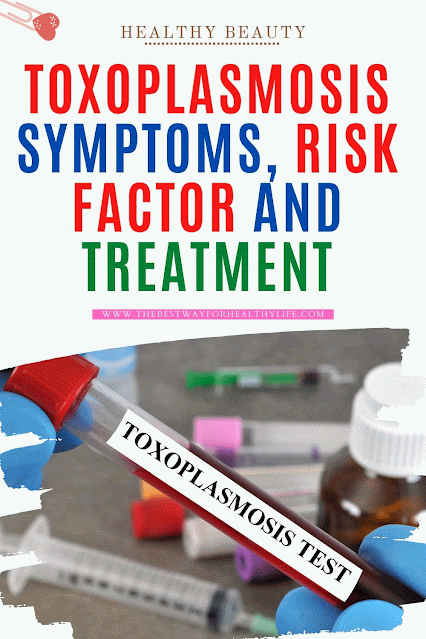Toxoplasmosis Sympthoms, Risk Factor and Treatment
 |
| toxoplasmosis symptoms |
Toxoplasma Gondii
Toxoplasmosis is an infection in humans caused by protozoan parasites (single-celled organisms) Toxoplasma Gondii (T. Gondii). Although this parasite can grow in the tissues of many animals, there is more in the body of a cat. These parasites lay eggs in the intestinal lining of cats and can come out with animal feces. Besides these parasites being often found in cat litter, they also can be found on undercooked meat.
T. Gondii parasitic infections in healthy people are generally not dangerous, because our immune system can control this parasitic infection. However, serious medical treatment needs to be done if this infection attacks someone with a low immune system or pregnant woman, in order to avoid severe complications.
Toxoplasmosis is spread from animals to humans, not between humans, except in pregnant women who can spread the infection to their fetuses. As a result, the fetus will develop slowly. Even in cases of more severe infections, miscarriage or fetal death can occur in the womb.
After toxoplasmosis occurs, the T. Gondii parasite can survive in the body in an inactive condition, thus providing lifelong immunity against this parasitic infection. But when the body's immune system weakens due to a disease or consumption of certain drugs, T. Gondii infection can reactivate and trigger more severe complications.
Symptoms of Toxoplasmosis
When T. Gondii attacks a healthy person, symptoms may not appear and the patient can fully recover. But in other cases, symptoms can appear for a few weeks and are similar to flu symptoms, such as fever, muscle aches, fatigue, sore throat, and swollen lymph nodes. These symptoms can improve within 6 weeks.
T. Gondii infections in infants and children are generally transmitted from the mother during pregnancy. More serious symptoms can be experienced by fetuses infected with this parasite in the early trimester of pregnancy, in the form of premature birth, miscarriage, or fetal death in the womb.
While babies born with the condition infected with T. Gondii (congenital toxoplasmosis) will show symptoms, such as:
- Yellowish skin.
- Chorionitis (inflammation) or infection in the back of the eyeball and retina.
- Enlarged liver and spleen.
- Skin rashes or bruises easily.
- Convulsions.
- A buildup of brain fluid in the head, so that the head becomes large (hydrocephalus).
- The head appears smaller (microcephalus).
- Intellectual impairment or mental retardation.
- Hearing loss.
- Anemia.
These symptoms can appear when the baby is born, or only appear a few months or a few years later.
Whereas in patients with immune disorders, symptoms of toxoplasmosis infection are characterized by:
- Difficulty speaking
- Visual impairment
- Hearing loss
- Dizziness
- Always confused
- Convulsions
- Coma (if toxoplasmosis attacks the brain)
- Rashes
- Fever
- Chills
- Weakness and shortness of breath, if toxoplasmosis spreads throughout the body.
The spread of T. Gondii infection in humans occurs by:
- Exposed to cat feces containing T.gondii parasites.
- Eating food or drinks contaminated with T. Gondii parasites, including raw meat that contains these parasites.
- Through the placenta of pregnant women, spreads the infection to the fetus.
- Through blood transfusions or organ transplants from donors infected with this parasite.
Risk Factor of Toxoplasmosis
There are several conditions that can increase the risk of toxoplasmosis becoming a serious health problem,
- Pregnant.
- Take long-term corticosteroid or immunosuppressive drugs.
- Suffered from HIV / AIDS.
- Currently undergoing chemotherapy.
Diagnosis of Toxoplasmosis Doctors can suspect a patient suffering from toxoplasmosis based on the symptoms that exist. To prove it, it is necessary to have a blood test to find out the body's antibody levels against the T. Gondii parasite. From blood tests, negative and positive results can be obtained. A negative result means the body has not been infected or is immune to the T. Gondii parasite. However, the implementation of this test can only be done when the body has not formed antibodies against this parasite, so the results will be negative. To be sure, this test needs to be repeated a few weeks later. While positive results indicate an infection in the body is active or this infection has happened before.
In patients who are positively infected with toxoplasmosis and at high risk of complications, the doctor will do an MRI scan to find out if the infection has spread to the brain.
Whereas in pregnant women, to find out whether toxoplasmosis affects the fetus, doctors need to do tests in the form of:
- Amniocentesis.
The doctor will take a sample of the patient's amniotic fluid when the gestational age is over 15 weeks. With this test, it can be known whether the fetus was infected with Toxoplasmosis or not.- Ultrasound.
This examination aims to look for abnormal signs in the fetus, such as hydrocephalus. After the birth process, the baby will undergo a series of tests to see the damage caused by the infection.Toxoplasmosis Treatment
The best treatment to cure toxoplasmosis is by avoiding the source of toxoplasmosis. If you are a cat lover, then make sure you always check your cat to the vet and make sure your cat is free from this virus. Always maintaining the cat litter cleanliness is the key to staying away from toxoplasmosis.
If you are already caught by toxoplasmosis virus, usually the doctor will provide an antibiotic, and you will recover without any complications. Complication only affects pregnant women, therefore if they are contaminated by this virus, further treatment is needed.
Post a Comment for "Toxoplasmosis Sympthoms, Risk Factor and Treatment"